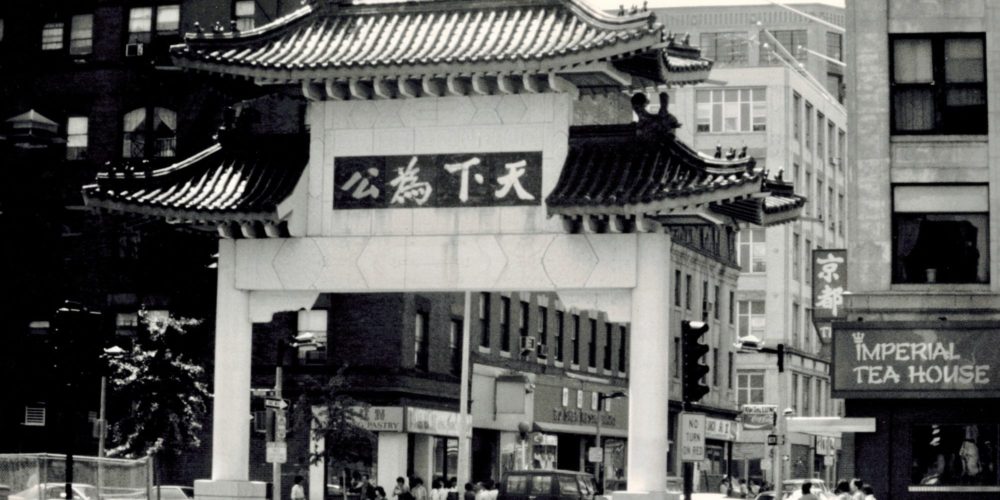
Archaeological Dig in Chinatown
In summer 2019, the Chinese Historical Society of New England (CHSNE) is working with the Boston City Archaeology Program on an archaeological dig at 6 Hudson Street in Chinatown
This project will doubtlessly uncover new information about the Boston Chinatown neighborhood’s history and community. We hope that you will follow the progress on social media, stop by the site, or even sign up as a volunteer.
Anyone can participate in the dig! The majority of digging and excavation is done by volunteers, and we’ve reserved a number of volunteer slots for members of the Chinatown community. No experience is necessary to join. Volunteers will be screening and digging on site, but you are not required to dig. Most will be helping sift soils to recover artifacts, with volunteers taking turns digging in the excavation hole. For more information and to sign up to volunteer, click here
We also welcome groups visits. Are you involved in a community group or organization? You can bring your group to the site for an overview of the project and a look into the most recent discoveries. For more information and to schedule, click here.
For real-time updates, follow the dig on Boston Archaeology’s Facebook and Twitter
Press
“Archeological dig unearths artifacts in Boston’s Chinatown,” Boston Globe, July 12, 2019 (pdf)
“波士顿华埠暗藏玄机 首次考古就挖到宝,” SinoVision, July 10, 2019
“Ink library, parking barnacles, lunar training grounds: News from around out 50 states,” USA Today, July 9, 2019
“Archaeology Dig Near Boston’s Chinatown Gate Gets Underway,” Patch Boston, July 8, 2019
“Archaeologists excavating Boston’s Chinatown in search of artifacts,” MassLive, July 8, 2019
“Work begins on first archaeology dig in Boston’s Chinatown,” WCVB, July 8, 2019
“First Archaeology Dig In Chinatown Underway,” WBZ CBS Boston, July 8, 2019
“Archaeologists Begin 1st Excavations of Boston’s Chinatown,” US News & World Report, July 8, 2019
“Archaeologist Looks To Dig Up History In Chinatown,” WBUR News, July 8, 2019
“Archaeology dig to focus on Chinese immigrants,” “華埠考古挖掘關注華人移民,” Sampan Newspaper, July 3, 2019
“Boston’s Chinatown Prepares for first archaeological dig,” WCVB, July 2, 2019
“City archaeology dig to start in Chinatown,” Boston Globe, July 1, 2019 (pdf)
Pre- 1830s: Filing of South Cove
Before the nineteenth century, 6 Hudson Street was tidal mudflats known historically as South Cove. At the time, 6 Hudson was located just east of the former shoreline of Boston, which roughly followed Harrison Avenue. In 1833, a “group of lawyers, merchants, and businessmen formed the South Cove Corporation for the express purpose of filling the flats” of South Cove. By 1838, 6 Hudson and the surrounding streetscape were created.
1938 – 1900: Early Occupants
The earliest residents of the house on 6 Hudson were Massachusetts-born, likely local families participating in the new job and living opportunities on the South Cove. By the 1870s, the house is functioning as a boarding house for Irish immigrants and first generation Americans. In the 1880s, the house likely became a three-family home with an apartment on each floor.
1899 – 1920: Syriatown
The turn of the twentieth century also marked a change in the neighborhood demographics, as a civil war in Syria brought a wave of Arab immigrants to the area. As such, the 1910 census indicates that all the 6 Hudson residents were recent immigrants from Syria.
1920 – Present: Chinatown
By the 1920s, over 1,000 Chinese people lived in Chinatown. Due to the Chinese Exclusion Act, the occupants were a “bachelor community” of mostly single men. After World War II, the number of families and American-born Chinese Americans increased.
Alongside other Chinese businesses on Hudson St, the famous Ruby Foo’s Den restaurant opened at 6 Hudson in 1929. Ruby Foo was one of the earliest Chinese female restaurateurs in the country and successfully catered to a non-Chinese and celebrity clientele at Chinatown’s “smartest restaurant.” The two floors above the restaurant served a rental housing for Chinese men, many of who worked for Ruby Foo. Ruby Foo’s Den was closed and the site was auctioned for back taxes in 1957.
The building was listed as vacant in 1988, and taken down in 1989.
Where is the dig taking place?
The dig is taking place at the vacant lot at 6 Hudson Street in Chinatown, right next to the Mary Soo Hoo Park and the Chinatown gate.
How long will the dig last?
The dig is expected to last through the end of August, for a total of eight weeks. However, the final end date is flexible and will not be confirmed until later in the dig.
What do you expect to find?
We hope to find artifacts related to the history of the South Cove neighborhood, including the American, Irish, Syrian, and Chinese people who lived and worked at the site. Previous archeology digs in Boston have uncovered over 10,000 artifacts!
What happens after the dig?
After excavation, the artifacts will be washed, sorted, and catalogued. The City Archeologist will publish the results of the dig in a formal archaeological report. The artifacts will be available for the public to to view at the the City’s Archeology Lab in West Roxbury.
Hudson Street's Chinese American History in Pictures
Although this excavation is limited to the parcel at 6 Hudson Street, the whole street served an important role in the neighborhood’s history. Its buildings housed residents, businesses, and organizations. It served as a common parade route and a place for children to run. Below are some photographs of Hudson Street from the past 100 years:

Memorial Service for Dr. Sun Yat-sen in Boston, 1925
Chinese revolutionary leader Dr. Sun Yat-sen gained widespread support from overseas Chinese in overthrowing the Qing dynasty in 1911. Chinese Nationalist Party branches were subsequently established in major American cities including Boston. The Boston branch was founded at 10 Hudson Street before it was relocated to 17 Hudson Street. Photographed is a group of Chinese Nationalist Party members in Boston in a solemn memorial service one month after the death of Dr. Sun outside the party branch office. (Frank and Kay Chin)

Women Raise Funds for the War Effort, 1940s
Ruby Foo's Den at 6 Hudson Street served as the backdrop for women raising money to support the Chinese war effort against Japan. The outstretched flag collected money tossed in by restaurant workers who responded to the appeal. (International Society)

Support of American Troops, 1941
Chinese demonstrators marched along Hudson Street in 1941, proudly displaying American flags in support of U.S. involvement in World War II. (Tunney Lee)

Chinese American Victory Parade, 1945
The celebration of the victory of China and the Allied Powers in the Pacific War reached its climax on the national day of the Republic of China, October 10, 1945. Chinatown held a spectacular victory parade along a route that included Hudson Street. Spectators and paraade floats overflowed the streets as part of a celebration that lasted for months. (International Society)

Children in the Hudson Street Neighborhood, late 1940s
Reggie and Caroline Wong, brother and sister, play and pose in front of the tenements of Hudson Street. It was a close-knit neighborhood where every school child knew each other by name or nickname. (Reggie Wong)

Ruby Foo's Den, 1951
Ruby Foo's Den at 6 Hudson Street was open in 1929. The owner Ruby Foo was one of the earliest Chinese female restaurant owners in the country. Her restaurant successfully catered to non-Chinese and a celebrity clientele. It was the most famous restaurant for non-Chinese customers in the 1930s. Ruby Foo passed away in 1950, and the restaurant was later closed in 1957. (CHSNE collection)

Hudson Street Before Urban Renewal, 1953
This photograph was taken prior to the demolition of Hudson Street homes and businesses. Three- and four- story brick tenement houses lined both sides of the street. Because of community concerns, instead of taking all of Hudson Street, the eastern side from Kneeland Street to Broadway was torn down to construct an entrance ramp for the Massachusetts Turnpike. (International Society)

Hudson Street Building Demolition, 1963
All of Albany Street and one side of Hudson Street, sough of Kneeland Street, were demolished after 1963 to make room for the Massachusetts Turnpike Extension. The demolition on Hudson Street added fuel to a growing anti-highway movement as the public began to question the price exacted on the neighborhoods and inhabitants. (CHSNE collection)
Chinese Historical Society of New England administrator
- Home
- About
- Events
- Programs▼
- Annual Meeting
- CHSNE Genealogy Workshop
- CHSNE Tunney F. Lee Memorial Lecture Series▼
- Coming to America
- “The Virulent Roots of American Violent Othering: Asians as disposable things, and other stories of dehumanization”
- Forever Struggle Activism, Identity, and Survival in Boston’s Chinatown, 1880-2018
- Laundry Rock: Histories of Boston’s Chinatown
- “Unsung Heroes: Recognizing and Honoring Chinese American World War II Veterans” Book Talk and Panel Discussion
- Stories from the City: Contemporary Chinese Senior Migrants and Boston’s Chinatown
- Lunch and learn
- Sojourner Award
- Mass. Memories Road Show
- Facing Exclusion
- Chinese-American Women Oral History Project
- Chinatown Tours
- Publications▼
- Archives▼
- Support▼
- Planning Your Visit
- Links
- Exhibits
- Exclusion Timeline
- Endurance Streets (堅韌的街道)
- These Words▼
- 150 Years of Chinese Students in America Initiative▼
- 中文







About the author